Meteors
The annual spectacle of the Geminid Meteors, which peak on the night of the 13th-14th December, are always worth looking forward to. Peaking at anything up to 100 meteors per hours (not all of which will be visible from any given location), the Geminids are arguably the most reliable shower of the year, fed by the mysterious "rock comet" asteroid 3200 Phaethon. The shower is expected to be visible from 4th/5th to the 17th December this year.
The Geminids radiate from an area inside the constellation of Gemini and are usually very well seen from the northern hemisphere. 2023’s shower is quite a reasonable scenario in terms of the influence of Moonlight, with the Moon at just past new almost completely out of the way. The Geminids present great opportunities for astrophotographic record - all you need is a solidly mounted camera, capable of timed exposures, with a reasonably wide field lens. Once set up - even in a fairly light polluted environment - you will be unlucky not to capture a couple of brighter meteors, given an hour-or-so’s multiple exposures. The brightest of the Geminids will cut through even the worst influence of light pollution.
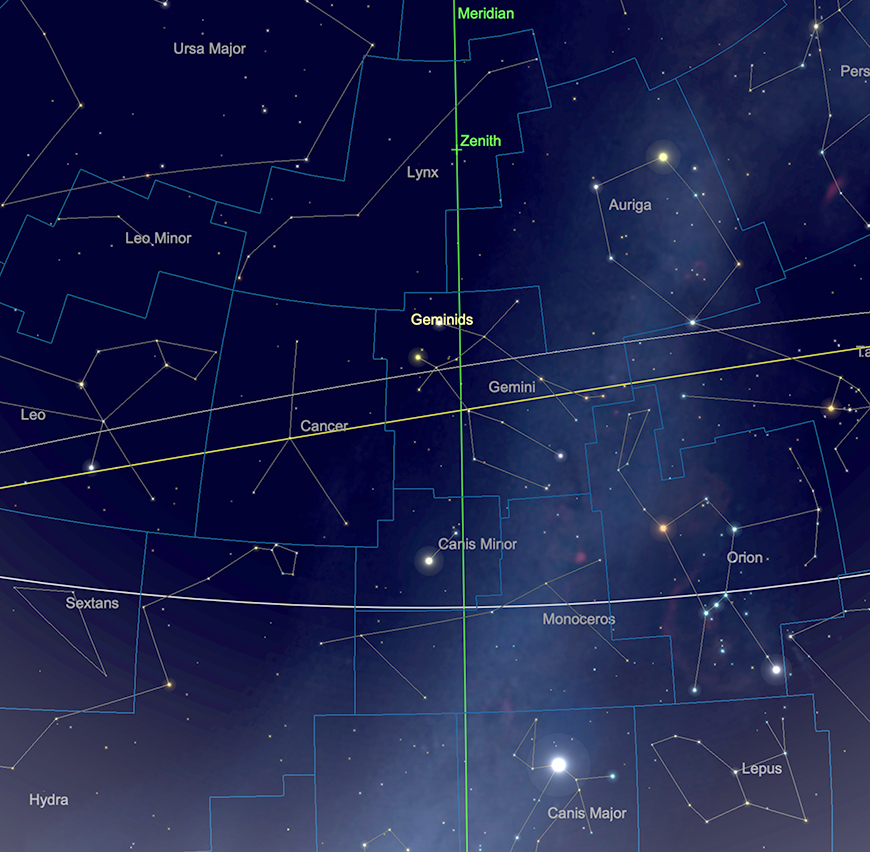
The Geminid radiant Image created with SkySafari 5 for Mac OS X, ©2010-2016 Simulation Curriculum Corp., skysafariastronomy.com.
Deep Sky Delights in Taurus and Aries
This month we shall examine the spectacular Taurus and its distinctly less-spectacular neighbour, Aries.
Taurus and Aries. Image created with SkySafari 5 for Mac OS X, ©2010-2016 Simulation Curriculum Corp., skysafariastronomy.com.
The zodiacal constellation of Taurus, The Bull, is home to some of the most outstanding deep sky objects in the sky, the most notable of these is perhaps M45, the Pleiades, or the Seven Sisters. At collective magnitude of +1.5, M45 is easily seen with the naked eye and has been recorded by numerous cultures throughout the world. The ancients knew the Pleiades by different names: Subaru in Japanese, Krittika in Hindi, Soraya in Persian amongst many others. The Pleiades are mentioned in Homer's Odyssey and Iliad, the Bible and the Quran. It is known that cultures as far apart as the Maori and Aborigines and the Native Plains Tribes of North America had knowledge of this star cluster - which makes it pretty well-known worldwide!
The Pleiades, M45. Image credit: Mark Blundell. Image used with kind permission.
M45 presents its nine major members, (named after siblings from classical Greek mythology), the "sister" stars of Merope, Sterope, Electra, Maia, Tygeta, Celaeno and Alcyone - along with the "parent" stars Altas and Pleione - to the naked eye from a very dark location, but most people with reasonable eyesight can split six under average skies. Telescopes and binoculars reveal many more of the 1000-or so members of the cluster and larger instruments and photography can pick up blue-hued reflection nebulosity surrounding the cluster - particularly around Maia and Merope. This nebulosity is caused by illumination of left-over material from the cluster's formation. The view of M45 with a widefield, low power eyepiece is one of the most glorious sights in any telescope, though at 2 degrees in diameter, one has to be careful about eyepiece choice in order to get the outlying members in a useable field of view.
The Pleiades are thought to be around 100 million years old and lie between 430 and 440 light years away.
Next door - though not cosmically speaking - to the Pleiades is the older and more spread-out Hyades cluster. Its major naked eye members are arranged in a V-shape which marks the head of Taurus. Again, similarly to M45, the Hyades have been known since antiquity and were traditionally seen by the Ancient Greeks as being the sisters of the Pleiades - via their shared father Atlas.
The distinct "V"shape of the Hyades, peeking through high cloud, shown in wide field. Image credit: Kerin Smith
The Hyades lie 152 light years away, and as such are nearest star cluster to us on Earth (though arguably the stars in the Plough or Big Dipper in Ursa Major can actually be thought of as a cluster and are closer). The Hyades consist of over 300 individual stars and modern estimates put its age at around the 600+ million year mark - making it markedly older than the Pleiades. The Hyades share a galactic trajectory with M44, the Beehive in nearby Cancer, again suggesting a common origin point in space. However, the Beehive appears to be slightly older at 600-730 million years.
Line of sight puts Taurus' principle Alpha star Aldebaran - the eye of the Bull - within the boundaries of the Hyades, though this Red Giant is unrelated and distinctly closer to us at 65 light years.
Reaching East down the Southerly "horn" of the Bull, we come to the +3 mag star Zeta Tauri. This star is a convenient location point for another jewel of the night sky - the Crab Nebula, M1 on Messier's List.
The Crab Nebula is the remnant of a star which went Supernova in the year 1054 (to us here on Earth). This event was recorded throughout the world, from New Mexico to China. It would have been a dazzling sight, peaking at -6 mag, brighter than the planet Venus and visible in daylight. After it faded, the event receded from popular consciousness and it was nearly 700 years later, in 1731, that the object than would become known as the Crab was discovered by Astronomer John Bevis. Messier rediscovered it when searching for the return of Halley's Comet 27 years later in 1758. First thinking the object was a comet, it was the Crab that prompted Messier to compile his list, so other comet-hunters would not be confused by these static, cloud-like objects when searching the heavens.
Lord Rosse, observing the Crab with what was then the largest telescope in the world at his Birr Castle Observatory in Ireland, in 1844, made a sketch that showed claw-like protrusions - presumably the filament structure of the outer lying regions. The object was nicknamed the Crab - and the moniker stuck.
Early both Century photographic observations of M1 showed that the object was expanding rapidly. This expansion was extrapolated backwards and it was noted that the object should have started its expansion around 900 years previously. A little bit of astronomical detective work ensued and the events of 1054 and the Crab were tied together.
Although a hardly dazzling +8.39 mag, the Crab's is quite well condensed and as such its surface brightness is fairly high. It can be found as a misty patch with ordinary binoculars, though larger binoculars reveal it as a definite elongated, round-edged feature. Telescopically, the texture of the Crab becomes evident in refractors of 4-inches aperture or reflectors of the 6-8-inch class. Reflectors of 16+ inches in aperture and dark skies are needed to glimpse the filament structures of M1's outlying regions and real striation in its core. Filtration will help with this object, especially in small instruments where it can sometimes be difficult to isolate the nebulosity of the object from the rich background of the Milky Way.
Photographically, the Crab Nebula is a rewarding target, with the "Hubble Palette" of H-Alpha, OIII and SII being particularly useful in bringing out the tangled, chaotic structure of the object's core. Though it can be very effectively recorded with single shot colour cameras, as displayed by Mark Blundel's picture below.
The Crab Nebula, M1. Image credit: Mark Blundell. Image used with kind permission.
No-one with any form of optical equipment should ignore the Crab Nebula. While not as spectacular is the neighbouring Orion Nebula, it is the only easily-observed remnant of a Supernova that humans have actually observed in relatively recent history. Given the dearth of Supernovae in our galaxy in recent times, the Crab remains a special object to us.
Where Taurus is rich with bright stars and interesting objects, Aries is much less so. However, it is not without interest. Aries has been known as a constellation since Egyptian and Mesopotamian times, but is now generally recognised to represent the Ram Chrysomallos, who was sent by Hermes (later the Roman equivalent, Mercury), to rescue Phrixus and Helle, the son and daughter of King Athamas and his Queen Nephele. Helle fell from the back of the Ram during the rescue, drowning in the Straits of Gallipoli, also known as the Hellespont (the sea of Helle). No sooner than Phrixus had made it to the safety of Colchis (now the Georgian Black Sea coast), he sacrificed the unfortunate Chrysomallos to give thanks for his rescue. Chrysomallos was placed in the sky as the constellation of Aries and his Golden Fleece (later to be the focus of the quest of Jason and the Argonauts) was placed in a sacred grove, guarded by a dragon.
Aries itself consists of only four bright stars, the principle of which is known as Hamal (Alpha Arietis). Hamal is second magnitude and is found near to Shertan (Beta Arietis: third magnitude) and Mesarthim (Gamma Arietis, fourth mag) with the outlying 41 Arietis (again, fourth magnitude) lying over 10 degrees to the east.
Of the four main stars in Aries, Gamma Arietis is the most interesting for regular telescopic astronomy. This is one of the most famous double stars in the sky, having been first observed as such in the mid 1660s by the English Astronomer Robert Hooke. Separated by just over 6 1/2 orc seconds the two components of gamma Aretis are very similar stars in terms of brightness and spectral type. With an orbital period of greater than 5000 years the two components stars can easily be split in small telescopes, making this a great target for those interested in getting into double star observation. The stars are thought to lie around 165 light years distance, based on the most modern observations made by the Hipparcos satellite. There are a few other double stars in Aries including Epsilon, Lambda and Pi Aretis - but none are as prominent and easily-observed as Gamma.
Aries is also home to a few galaxies, many of which are in the 13th to 14th magnitude range and subsequently only readily observable for those with larger instruments. The brightest of these is in NGC772, A fascinating spiral galaxy which is thought to be twice the mass of the Milky Way. This galaxy shows extended spiral arms including one large one thought to be drawn out from the central galaxy by the tidal effects of its satellite galaxy NGC770. Although NGC 772 is listed as a 10th magnitude object it is a fairly low surface brightness, so will need a reasonable aperture telescope to observe. There were two notable supernovae observed in quick succession in 2003 within NGC 772 - this was quite a rarity, with both being visible at the same time.
NGC722. Image credit: Goran Nilsson & The Liverpool Telescope. Creative Commons
Text: Kerin Smith

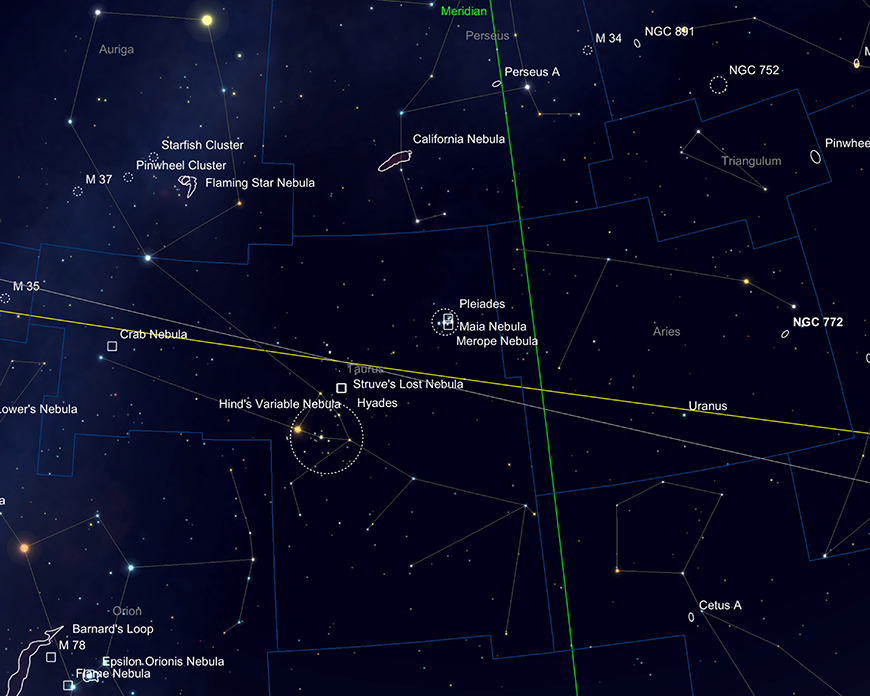
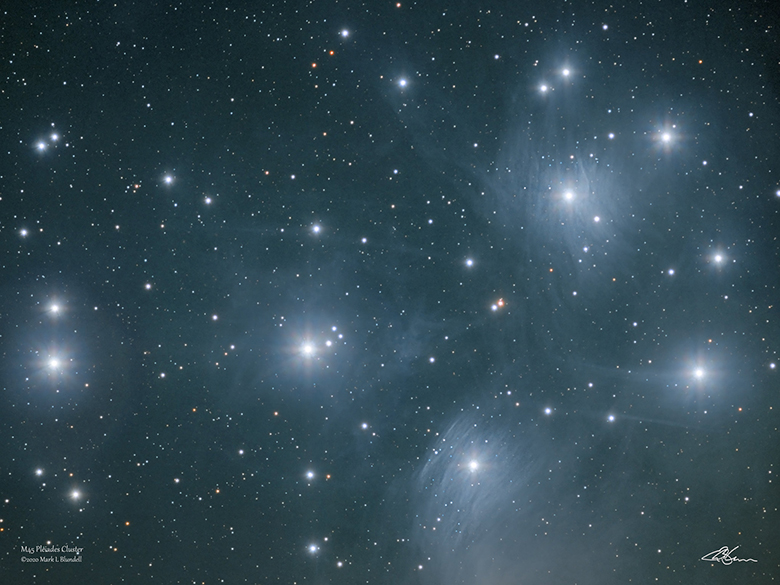
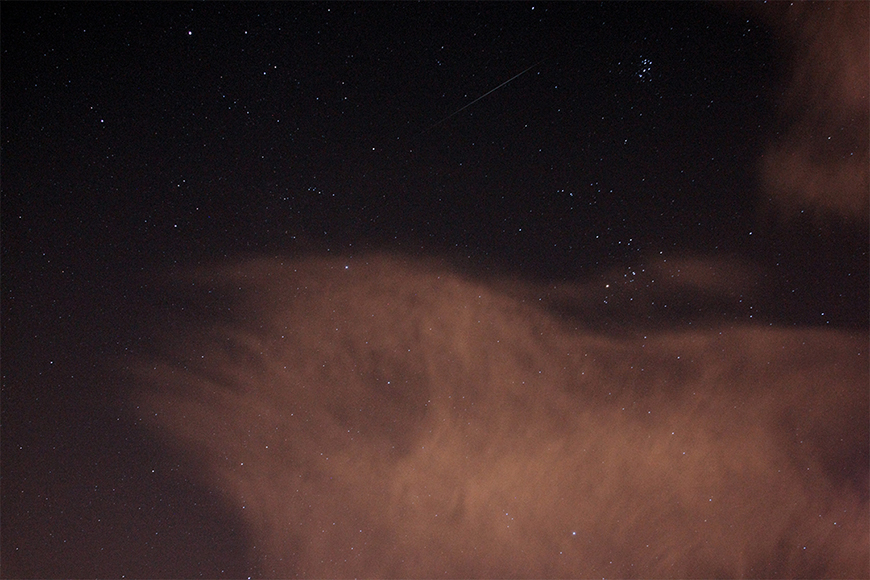
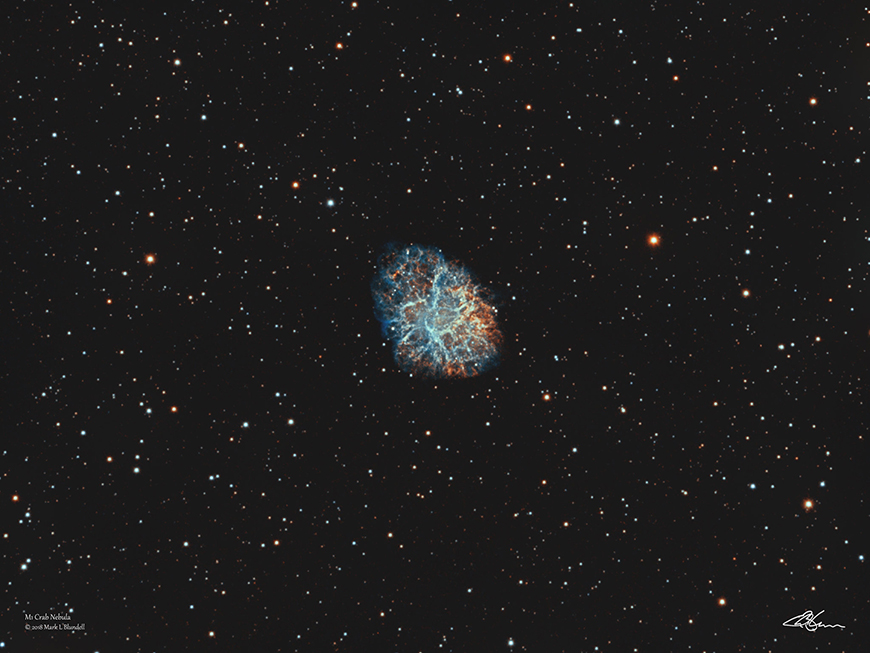
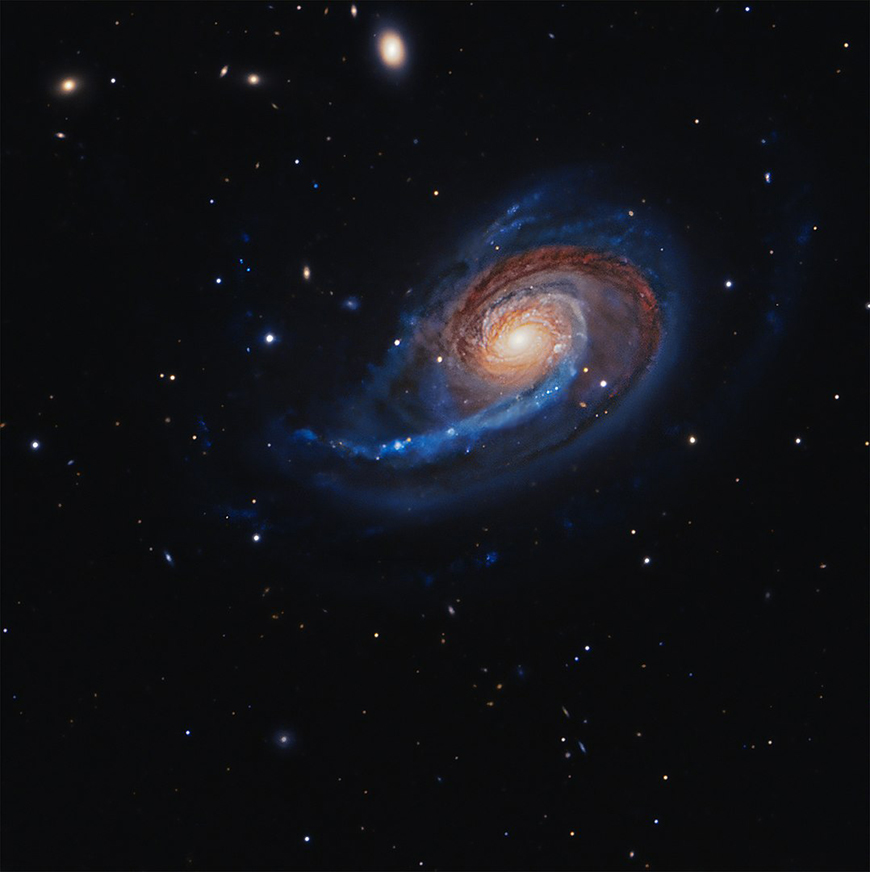

 English
English